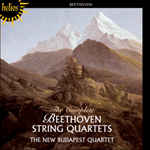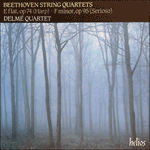
Welcome to Hyperion Records, an independent British classical label devoted to presenting high-quality recordings of music of all styles and from all periods from the twelfth century to the twenty-first.
Hyperion offers both CDs, and downloads in a number of formats. The site is also available in several languages.
Please use the dropdown buttons to set your preferred options, or use the checkbox to accept the defaults.

| Delmé Quartet» More |
Beethoven called Op 95 'Quartetto serioso' — a curious step to take when so many of his works could scarcely be said to lack seriousness, and the fact that he showed at first some reluctance to let the work be published suggests it held for him some special significance at which we can only guess. It is one of the most compact of all his works and his shortest quartet; yet it has an astonishing variety and scope both of character and material, achieved through a power of suggestion that contrives to create space where there seems not enough to contain all these things. The amazingly terse opening has a rhythmic subtlety that causes its answer on the flat supertonic (a semitone higher) suddenly to withdraw — the mysterious harmonies that follow already create a sense of space and when Beethoven comes to the second theme he is able to allow it to expand, almost with leisure, without the slightest suggestion of diffuseness. This is composition of the very greatest order. The first movement is unusually short but gives the impression of incalculable dimensions and limitless power.
The remarkable Allegretto is in the remote key of D major and contains two main elements — a cantabile main theme and a second subject treated as a highly individual and expressive fugato. Deeply disturbed polyphony dominates the heart of the movement, and during this time there is a passage of astounding non-contrapuntal modulations followed by another fugato where the theme gets shorter and shorter, losing notes from the tail backwards — a phenomenon probably unique in classical music. This passage, seeming to lose its subject, prepares the way for the return of the first theme. But the fugato theme is not altogether lost — it reappears later in the lower parts, rising briefly to the surface as part of the melodic flow of the 'main' theme before vanishing again. The end is inconclusive and the Scherzo breaks in abruptly.
Beethoven does not call it a scherzo. He used this term only literally, when humour or wit was intended. There is no humour in this fierce piece, nor in the wonderful Trio, unlike anything else in quartet literature and also unique in occurring twice in different forms, the second time with even more marvellous modulations than before. The final statement of the blunt Scherzo is sharply truncated and speeded up.
The finale opens with a short but deeply elegiac introduction, leading to a movement of extraordinary tortuous grace — a dance of despair, some might think, anticipating in some ways the last movement of the late A minor Quartet. But despair is not an element in Beethoven's art. Profoundly disturbing as he can be, he cannot express mere depression, for the human energy of his work is irrepressible, breaking through the most terrible agonies of his life and prodigious creative efforts. This is one of the works where he achieves the apparent impossibility of totally convincing dissociation — in this case in the gloriously fleet and elated F major coda. What does it mean? We have already thought of a possible extra-musical explanation, but it doesn't have to 'mean' anything except the miracle it performs. The other great works in which dissociation is a positive and paradoxically unifying force — on a much greater scale — are the last piano sonata in C minor, Op 111, and the late B flat Quartet, Op 130. The F minor Quartet and the Egmont Overture are the first notable examples of this phenomenon, of which Beethoven was the first and perhaps the only master.
from notes by Robert Simpson © 1991
Beethoven appela l'opus 95 'Quartetto serioso' — choix curieux, puisque maintes de ses oeuvres ne manquent pas particulièrement de sérieux, et le fait qu'il était au début peu disposé à faire publier l'ouvrage suggère que celui-ci avait pour lui une importance spéciale que nous ne pouvons qu'essayer de deviner. C'est l'une de ses oeuvres les plus concises et son quatuor le plus court; pourtant il comporte une étonnante variété et étendue à la fois de matériau et de caractère, obtenues grâce à une force de suggestion qui trouve le moyen de créer de l'espace là où il paraît ne pas y en avoir assez pour contenir tout ce que le compositeur y écrit. L'ouverture étonnamment laconique possède une subtilité rythmique qui cause la disparition soudaine de sa réponse sur la sus-tonique bémol (un demi-ton plus haut) — les harmonies mystérieuses qui suivent créent déjà un sentiment d'espace et quand Beethoven en vient au second thème, il peut lui permettre de se développer, presque à loisir, sans la moindre suggestion de verbiage. C'est une composition de premier ordre. Le premier mouvement est inhabituellement bref mais donne une impression de dimensions incalculables et de puissance illimitée.
Le remarquable Allegretto est dans le ton distant de ré majeur et comporte deux elements principaux — un thème principal cantabile et un second sujet traité comme un fugato extrêmement individuel et expressif. Une polyphonie profondément perturbée domine le coeur du mouvement durant lequel il y a un passage de stupéfiantes modulations non-contrapuntiques suivies d'un autre fugato dont le thème va en se raccourcissant de plus en plus, perdant des notes en rétrogradant depuis la fin — phénomène probablement unique dans la musique classique. Ce passage, qui paraît perdre son thème, ouvre la voie au retour du premier thème. Mais le thème du fugato n'est pas tout à fait perdu — il réapparaît plus loin dans les parties basses, remontant brièvement à la surface comme partie du flot mélodique du thème 'principal' avant de disparaître de nouveau. La fin est peu convaincante et le Scherzo l'interrompt brusquement.
Beethoven ne l'appelle pas un scherzo. Il ne se sert de ce terme que littéralement, avec une intention d'humour ou d'esprit. Il n'y a pas d'humour dans ce morceau implacable, ni dans le merveilleux Trio, qui n'a pas d'égal dans toute l'écriture de Quatuors et qui est aussi unique parce qu'il survient deux fois sous des formes différentes, la seconde fois avec des modulations encore plus merveilleuses qu'auparavant. La formulation finale du brusque Scherzo est coupée court et accélérée.
Le finale débute avec une introduction courte mais profondément élégiaque, menant à un mouvement d'une grâce extraordinairement sinueuse — une danse du désespoir, pourrait-on penser, anticipant en quelque sorte le dernier mouvement du dernier Quatuor en la mineur. Mais le désespoir n'est pas un élément de l'art de Beethoven. Aussi profondément troublé qu' il puisse être, il ne peut exprimer une simple dépression, car l'énergie humaine de son oeuvre est irrépressible, et surgit dans les pires angoisses de sa vie et dans ses prodigieux efforts créateurs. Ce quatuor est une de ses oeuvres où il réussit l'apparente impossibilité d'une dissociation convaincante — ici dans la coda en fa majeur glorieusement légère et pleine d'allégresse. Que cela veut-il dire? Nous avons déjà pensé à une explication extra-musicale, mais vraiment cela n'a pas besoin de 'signifier' quelque chose à part le miracle qu'il accomplit. Les autres grandes oeuvres dans lesquelles la dissociation est une force positive et paradoxalement unifiante — sur une bien plus grande échelle — sont la dernière sonate pour piano en ut mineur, op 111, et le tardif Quatuor en si bémol, op 130. Le Quatuor en fa mineur et l'Ouverture d'Egmont sont les premiers exemples à retenir de ce phénomène, dont Beethoven est le premier et peut-être le seul maître.
extrait des notes rédigées par Robert Simpson © 1991
Français: Alain Midoux
Beethoven bezeichnete op. 95 als 'Quartetto serioso' — eine seltsame Maßnahme, da sovielen seiner Werke gewiß kein Mangel an Ernsthaftigkeit nachgesagt werden kann. Die Tatsache, daß er sich zunächst gegen eine Veröffentlichung des Werks sträubte, deutet daraufhin, daß er ihm besondere Bedeutung beimaß, eine Bedeutung, die wir nur erraten können. Es handelt sich um eines seiner kompaktesten Werke und um sein kürzestes Quartett; dennoch wirkt es vom Charakter und Material her erstaunlich vielfaltig und breit gefächert. Dies wird durch Suggestion erreicht, die es fertigbringt, Raum zu schaffen, wo nicht genug zu sein scheint, um alle Inhalte aufzunehmen. Die verblüffend knappe Eröffnung veranlaßt rhythmisch subtil die um einen Halbton erhöhte Beantwortung zum plötzlichen Rückzug. Die geheimnisvollen Harmonien, die sich anschließen, rufen bereits das Gefühl räumlicher Weite hervor, so daß Beethoven, wenn er das zweite Thema erreicht, dessen geradezu lässige Expansion gestatten kann, ohne weitschweifig zu wirken. Das ist Kompositionskunst allererster Ordnung. Der erste Satz gerät ungewöhnlich kurz, hinterläßt iedoch den Eindruck unauslotbarer Dimensionen und grenzenloser Energie.
Das bemerkenswerte Allegretto steht in der entlegenen Tonart D-Dur und umfaßt zwei Hauptelemente — ein cantabile zu spielendes Hauptthema und ein Seitenthema, das als höchst individuelles, ausdrucksvolles Fugato gestaltet ist. Zutiefst unstete Polyphonie bestimmt den Kern des Satzes, und währenddessen kommt es zu einer Passage überraschender, nicht kontrapunktischer Modulationen, gefolgt von einem weiteren Fugato, in dessen Verlauf das Thema immer kürzer wird. Es verliert von seinem Schluß er eine Note nach der anderen — ein in der klassischen Musik wohl einmaliges Phänomen. Diese Passage bereitet, indem sie ihr Thema einzubüßen scheint, der Rückkehr des ersten Themas den Weg. Aber das Fugato-Motiv ist nicht endgültig verloren — es taucht spatter in den unteren Stimmen wieder auf und steigt im melodischen Fluß des 'Hauptthemas' kurz an die Oberfläche, ehe es wieder verschwindet. Das Ende ist nicht schlüssig, und das Scherzo bricht jäh ab.
Beethoven selbst bezeichnete es nicht als Scherzo. Er gebrauchte den Begriff ausschließlich wörtlich, wenn er an Humor und Witz dachte. An diesem grimmigen Stück ist jedoch nichts Humorvolles, auch nicht an dem wunderbaren Trio, das sich vom gesamten Quartettrepertoire abhebt und außerdem dadurch einmalig ist, daß es zweimal in unterschiedlicher Form vorkommt, und zwar beim zweiten Mal mit noch wundersameren Modulationen als zuvor. Die abschließende Aussage des schonungslosen Scherzos ist stark beschnitten und beschleunigt.
Das Finale beginnt mit einer kurzen, aber höchst elegischen Introduktion, die in einen Satz von außergewöhnlich verschlungener Grazie überleitet — in einen Tanz der Verzweiflung, möchte man meinen. Aber Verzweiflung hat in Beethovens Kunst keinen Platz. So sehr er zu beunruhigen vermag, ist er doch unfähig, bloße Niedergeschlagenheit auszudrücken, denn die menschliche Energie seines Schaffens ist unbezähmbar. Sie bricht sich Bahn durch die entsetzlichen Qualen seines Lebens, durch all seine fruchtbaren kreativen Anstrengungen. Das vorliegende ist eines der Werke, in denen er das scheinbar Unmögliche einer vollständig überzeugenden Distanzierung vollbringt — hier in Gestalt der herrlich schwebenden, erhabenen Coda in F-Dur. Was hat sie zu bedeuten? Wir haben bereits an eine mögliche außermusikalische Erklärung gedacht, aber mehr 'Bedeutung' als das Wunder, das sie bewirkt, muß man sich nicht erwarten. Die übrigen bedeutenden Werke, in denen Distanzierung als positive in — in wesentlich größerem Maßstab — paradoxerweise einende Kraft auftritt, sind die letzte Klaviersonate in c-Moll, op. 111, und das späte Quartett in B-Dur, op. 130. Das Quartett in f-Moll und die Egmont-Ouvertüre sind jedoch die ersten herausragenden Beispiele dieses Phänomens, das Beethoven als erster und wahrscheinlich einziger gemeistert hat.
aus dem Begleittext von Robert Simpson © 1991
Deutsch: Anne Steeb/Bernd Müller
 Beethoven: String Quartets Beethoven: String Quartets‘Fine performances, always intelligent, with many considerable insights … perfect intonation and excellent ensemble and tonal blend, with first-c ... ‘Very fine … I enjoyed these performances because they deliver Beethoven as I want him, free of the biographical sensationalism. Highly recommend ...» More |
 Beethoven: String Quartets Opp 74 & 95 Beethoven: String Quartets Opp 74 & 95 |

